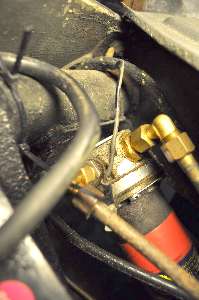The MGA With An Attitude
Fuel Tank ELECTRICAL GROUNDING -- FU-101
 The fuel tank on the MGA is electrically isolated from the chassis of the car. The tank is mounted in two steel band straps, but these should be lined with rubber packing strips. The tank filler neck has a rubber seal around it on the trunk floor, and is connected to the filler pipe with a rubber hose. This electrical isolation can be a problem for operation of the dash mounted fuel gauge. The fuel level sender unit which is mounted in the right side of the fuel tank requires electrical grounding for proper operation of the gauge. The factory original setup has the sender unit grounded to the tank, and the tank connected to the metal fuel pump body with a steel pipe, and the fuel pump having a ground wire to the chassis (bypassing the rubber isolator mount for the pump). If any of the electrical grounding path here is disrupted, the fuel gauge can malfunction. The picture shows the fuel pump grounding wire running to the top bolt for the toe board mount. This bolt should be a little longer than the rest to allow installation of a flat washer and hex nut for the wire connection.
The fuel tank on the MGA is electrically isolated from the chassis of the car. The tank is mounted in two steel band straps, but these should be lined with rubber packing strips. The tank filler neck has a rubber seal around it on the trunk floor, and is connected to the filler pipe with a rubber hose. This electrical isolation can be a problem for operation of the dash mounted fuel gauge. The fuel level sender unit which is mounted in the right side of the fuel tank requires electrical grounding for proper operation of the gauge. The factory original setup has the sender unit grounded to the tank, and the tank connected to the metal fuel pump body with a steel pipe, and the fuel pump having a ground wire to the chassis (bypassing the rubber isolator mount for the pump). If any of the electrical grounding path here is disrupted, the fuel gauge can malfunction. The picture shows the fuel pump grounding wire running to the top bolt for the toe board mount. This bolt should be a little longer than the rest to allow installation of a flat washer and hex nut for the wire connection.
One very common way that the fuel tank ground circuit is broken is by installing an after market fuel pump. This usually requires cutting the end fittings off of the steel fuel line and connecting the new fuel pump with rubber hoses, which breaks the original electrical ground connection at the fuel pump. You might get a ground connection to the frame at a P-clip which secures the steel fuel line to the chassis. You might get a ground connection if the rubber packing strips around the tank are frayed, allowing contact between the tank and the steel mounting bands. If these metal parts are well painted (or just rusty) you may more likely not have any reliable ground connection for the tank.
The easy fix for this problem is to install a grounding wire from one of the screws on the sending unit to a screw on the frame nearby where there is a P-clip holding the wiring harness. That way the fuel tank and the sending unit will always have a good chassis ground connection regardless of what happens at the fuel pump.
Another problem that may occur occasionally, if you drive on wet or snow covered roads, is an accumulation of "mush" on the right end of the fuel tank around the fuel level sender unit. This "mush" might be wet dirt or salt laden snow (thrown up by the tire), either of which could be electrically conductive (with some resistance). The MGA fuel level sender unit should have zero resistance when the tank is empty, and about 70 ohms resistance when full. Some "mush" accumulated around the sender unit can provide a parallel resistive grounding path for the signal wire, effectively reducing the resistance seen by the fuel gauge. This can make the fuel gauge read artificially low, possibly leading you to think you could be running out of fuel early.
When you understand what it going on here, it is not much to worry about. What it does is to make the fuel gauge reading non-linear and less accurate with higher fuel level. But as the fuel level approaches empty, and the sender internal resistance approaches zero, the external resistive path around the sender unit carries progressively less current. This means the fuel gauge will be more accurate as it approaches the empty mark, you don't run out of fuel any sooner, and "E" still means empty.
|